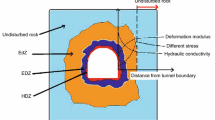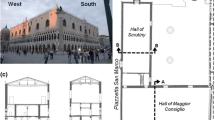Abstract
A case study on the use of direct and indirect investigations for the effectiveness evaluation of jet-grouting interventions for bridge scour protection is presented. The major concern of this scour countermeasure is that a reliable verification and imaging of the exact dimensions and shape of the grouted elements and their related strength and integrity are difficult to obtain. An integrated cost-effective and slightly invasive approach, by means of indirect surveys, is proposed in this work to limit re-drilling and core sampling of jet columns. Tests are performed on a bridge located in the Province of Cuneo (NW Italy). On site, active fluvial activity was scouring four of the 19 bridge piers and jet-grouting interventions were designed to prevent bridge collapse. A dual approach was consequently applied to evaluate the goodness of jet-grouting treatments: results of direct tests (visual and mechanical characterization of core drillings, with Point Load and Uniaxial Compressive Strength tests) have been compared to indirect investigations (seismic down-hole tests and 2-D cross-hole tomography, laboratory Ultrasonic Pulse Velocity measurements). All the techniques showed potentiality in identifying variations of the jet-grouting properties within the columns. Generally, worsening in jet-grouting properties was coherently identified by a decrease in the seismic velocities and in the mechanical parameters and confirmed by visual inspection of core drillings. Local anomalies and discrepancies between the adopted method were however highlighted and critically discussed as a function of the limitations, disturbances and investigated volumes of each method.













Similar content being viewed by others
References
ASTM (2002) Standard test method for laboratory determination of point load strength index of rock. D5731-02, American Society for Testing and Materials, West Conshohocken, Pennsylvania, USA
ASTM (2008) Standard test method for laboratory determination of pulse velocities and ultrasonic elastic constants of rock. D2845-08, American Society for Testing and Materials, West Conshohocken, Pennsylvania, USA
Barkdoll BD, Ettema R, Melville BW (2007) Countermeasures to protect bridge abutments from scour. National Cooperative Highway Research Program, Report No. 587, Transportation Research Board, Washington DC
Barton N (2007) Rock quality, seismic velocity, attenuation and anisotropy. Taylor & Francis, London
Bowden AJ, Black JL, Ullyott S (1998) Point load testing of weak rocks with particular reference to chalk. Q J Eng Geol Hydrogeol 31:95–103
Colombero C, Comina C, Giuliani A, Mandrone G (2016) Ultrasonic equipment aimed to detect grouting homogeneity in geothermal heat exchangers. Proc European Geothermal Congress 2016, Strasbourg, 19–23 September, T-HP-336
Croce P, Flora A, Modoni G (2014) Jet grouting: technology, design and control. CRC Press
De Falco F, Mele R (2002) The monitoring of bridges for scour by sonar and sediment. NDT & E Int 35(2):117–123
Deng L, Cai CS (2010) Bridge scour: prediction, modeling, monitoring and countermeasures – review. Pract Period Struct Des Constr 15:125–134
Gemmi B, Morelli G, Bares FA (2003) Geophysical investigations to assess the outcome of soil modification work: measuring percentile variations of soil resistivity to assess the successful modification of foundation soil by jet grouting. Grouting and Grout Treatment - Proceedings: 1490–1506
Hayes DC, Drummond FE (1995) Use of fathometers and electrical-conductivity probes to monitor riverbed scour at bridges and piers. Water Resource Investigation Rep. No. 94-4164, U.S. Geological Survey, Hartford, Connecticut
Jahanger ZK, Azad Abbas A (2013) Correlation between point load index and very low uniaxial compressive strength of some Iraqi rocks. Aust J Basic Appl Sci 7(7):216–229
Kahraman S, Gunaydin O, Fener M (2005) The effect of porosity on the relation between uniaxial compressive strength and point load index. Int J Rock Mech Min Sci 42(4):584–589. https://doi.org/10.1016/j.ijrmms.2005.02.004
ISRM (1979) Suggested methods for determining uniaxial compressive strength and deformability of rock materials. International society for rock mechanics, commission on standardization of laboratory and field tests. Int J Rock Mech Min Sci Geomech 16:135–140
ISRM (1981) Rock characterization, testing and monitoring: ISRM suggested methods. Editor: Brown ET, Pergamon Press, 211 pp
ISRM (1985) Suggested methods for determining point load strength
Lagasse PF, Zevenbergen LW, Schall JD, Clopper PE (2001) Bridge scour and stream instability countermeasures: experience, selection and design guidelines. Federal Highway Administration, Hydraulic Engineering Circular No. 23: FHWA NHI 01-003, U.S. Department of Transportation, Washington DC
Lytle RJ, Dines KA, Laine EF, Lager DL (1978) Electromagnetic cross-borehole survey of a site proposed for an urban transit station. UCRL-52484, Lawrence Livermore Laboratory, University of California
Millard SG, Bungey JH, Thomas C, Soutsos MN, Shaw MR, Patterson A (1998) Assessing bridge pier scour by radar. NDT & E Int 31(4):251–258
Padura AB, Sevilla JB, Navarro JG, Bustamante EY, Crego EP (2009) Study of the soil consolidation using reinforced jet grouting by geophysical and geotechnical techniques: “La Normal” building complex (Granada). Constr Build Mater 23:1389–1400
Park I, Lee J, Cho W (2004) Assessment of bridge scour and riverbed variation by a ground penetrating radar. Proceedings 10th International Conference on Ground Penetrating Radar: 411–414, Delft, The Netherlands
Parker GW, Bratton L, Armstrong DS (1997) Stream stability and scour assessments at bridges in Massachusetts. US Geological Survey Open File Report No. 97-588 (CD ROM), Massachusetts Highway Dept. Bridge Section, Marlborough, Massachusetts
Peterson JE, Paulson BNP, McEvilly TV (1985) Applications of algebraic reconstruction techniques to crosshole seismic data. Geophysics 50:1566–1580
Rucker ML (2006) Surface geophysics as tools for characterizing existing bridge foundation and scour conditions. www.memphis.edu/ce/
Santarato G, Ranieri G, Occhi M, Morelli G, Fischanger F, Gualerzie D (2011) Three-dimensional electrical resistivity tomography to control the injection of expanding resins for the treatment and stabilization of foundation soils. Eng Geol 119(1–2):18–30. https://doi.org/10.1016/j.enggeo.2011.01.009
Singh TN, Kainthola A, Venkatesh A (2012) Correlation between point load index and uniaxial compressive strength for different rock types. Rock Mech Rock Eng 45(2):259–264. https://doi.org/10.1007/s00603-011-0192-z
Sonmez H, Gokceoglu C, Medley EW, Tuncay E, Nefeslioglu HA (2006) Estimating the uniaxial compressive strength of a volcanic bimrock. Int J Rock Mech Min Sci 43:554–561
Tucker SE, Briaud JL, Hurlebaus S, Everett ME, Arjwech R (2015) Electrical resistivity and induced polarization imaging for unknown bridge foundations. J Geotech Geoenviron Eng 141(5):04015008
Um J, Thurber CH (1987) A fast algorithm for two-point seismic ray tracing. Bull Seismol Soc Am 77:972–986
Zacoeb A, Ishibashi K (2009) Point load test application for estimating compressive strength of concrete structures from small core. J Eng Appl Sci 4(7):46–57
Acknowledgements
Surveys of this work have been financed under an agreement between Earth Science Department of University of Torino and Cuneo Provincial Authority. The authors are indebted to Politecnico di Torino for their permission of the use of seismic instrumentation.
Author information
Authors and Affiliations
Corresponding author
Rights and permissions
About this article
Cite this article
Bonetto, S., Colombero, C., Comina, C. et al. A case study on the application of destructive and non-destructive methods for evaluating jet-grouting column integrity for bridge-pier scour protection (Cuneo, NW Italy). Bull Eng Geol Environ 77, 541–553 (2018). https://doi.org/10.1007/s10064-017-1223-0
Received:
Accepted:
Published:
Issue Date:
DOI: https://doi.org/10.1007/s10064-017-1223-0




